A Paipo
Interview with Mike Broderick
December 5, 2012 - Kailua, Oahu (Hawaii)
Interview by John Clark, based on questions by Bob Green
|
Introduction.
Mike was a Makapu'u regular from the 1950s. Around 1963, Mike began
riding a paipo with a Playboy Playmate on the deck and later on he used
a Val Valentine "Paipo Nui" board. Makapu`u was his second home, a
place where bodysurfers and paipo riders co-existed. Mike doesn't ride
a paipo anymore but continues to spend time in and under the water,
with friends he made many years ago surfing Makapu`u.
1. How
did you get into riding paipo boards and what was your first board like?
I was born in Honolulu
and went to Stevenson
Intermediate School and then Roosevelt High School. I graduated in
1960. When I was in the 9th grade at Stevenson, I made a redwood paipo
board with a skeg at school in wood shop. That was my first board. I
used it mostly at Canoes in Waikiki and at Ala Moana. I remember Donald
Takayama surfing there, too. In high school, I made a foam paipo board
out of waterproof insulating foam and put a plastic skeg on it. That
board was about 20" wide and 3' long, rounded in the front, and square
in the back. I broke it at Makaha. By that time we were surfing there
and at Yokohama.
Pictured to the
right are John Clark and
Mike Broderick, ca. 2013. Mike is holding his board from the 1960s,
minus the Playboy Playmate. Photo
by Sachi Clark, courtesy of John Clark.
|
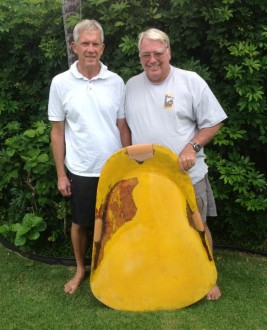
|
Figure 1. Left
to right: John Waidelich, Jim Growney, Jaren Hancock, Mike Broderick
and John Naughton - Yokohama Beach, ca. mid- to late-1960s.
|
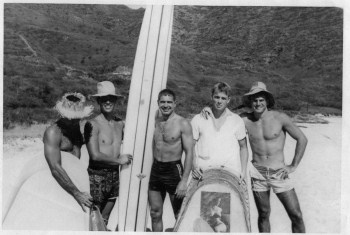
|
Of the
board: "The board is under repair but still looks the same except for
the Playboy Playmate that my brother removed (see above photo). When I
was building my
board I wanted something different on it rather them a Hawaiian print
so I selected a particular playmate that I thought was great and
glassed it right into the board. I also had a sand sliding or skim skim
board with another one on that. I am afraid that is gone now. The board
drew a lot of attention. When I look at the photo now it's obvious why
I selected it." |
Photo
courtesy of Jaren Hancock/Jim Growney and Mike Broderick. |
2. In your
e-mail you said that you went to Makapu`u every week-end for 15 years.
When did you first go there?
It would have been
about 1957, when I was in
the 10th grade. My older brother had a car, so we all pitched in for
gas and he'd drive us out there.
Figure 2. Makapu`u.
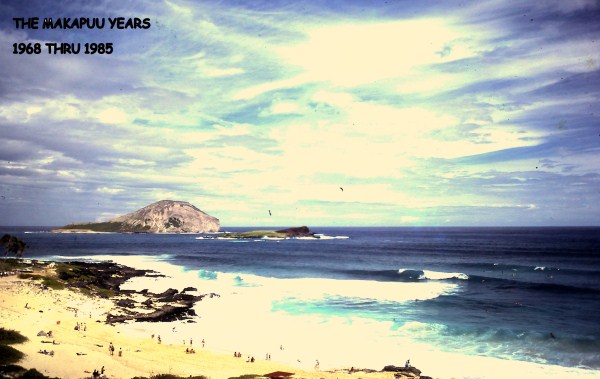
Photo
courtesy of Darel Shea.
3. What was the attraction
of Makapu`u?
Makapu`u has lots of
breaks. You can ride the
shorebreak, go left at the point, and on big days go right or left from
the middle of the bay. We rode it so much it was our spot. And it was
off limits for surfboards. John Waidelich and Jim Growney were the ones
who got the zoning changed to no surfboards. That turned out great for
paipo riders.
Figures 3.1 and 3.2. Makapu`u.
|
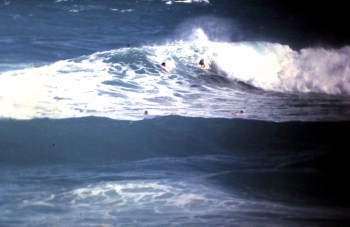
|
|
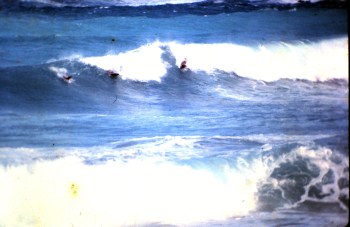
|
Photos
courtesy of Darel Shea.
4. When was the heyday of
paipo riding at Makapu`u and how many paipo riders would be out on a
good day? What was
the atmosphere like out in the water and how were things between
bodysurfers and paipo riders?
The heyday of paipo
riding was up until the
1970s when the Morey boogie boards came out. On good days there were 12
to 15 paipo riders in the water, and everyone else bodysurfed. There
weren't any problems between the bodysurfers and the paipo riders. The
paipo riders were usually outside and the bodysurfers were mostly
inside. Everyone had their own spot, and everyone got along.
5. Did everyone basically
have the same approach to riding a paipo or were there noticeable
differences in style and technique?
Almost all the paipo
riders rode prone, but
a few rode on their knees. Some guys would put one arm out when they
were riding down the line. The younger kids from Waimanalo did stuff
like 360s and El Rollos, but we didn't.
6. Who do you particularly
remember
surfing Makapu`u? Craig Matthew suggested to ask you about: Frank and
Renny Kruger, John Waidelich, John "Dinty" Moore, "Toby" Tobin , Pete
Crooker and Ed Stroup?
Harry Akisada was
one of the best. When he
went out, he'd stay out all day. He wouldn't come in. In addition to
myself, there was John Waidelich, Craig Matthew, Renny Kruger, and of
course, the guys from Waimanalo, like Jerry Waiolama, Black Lum King,
and Lymie Wilson.
Figure 6.1. Jaren
Hancock. The board in the background is similar to boards made and
ridden by "Toby" Tobin.
|
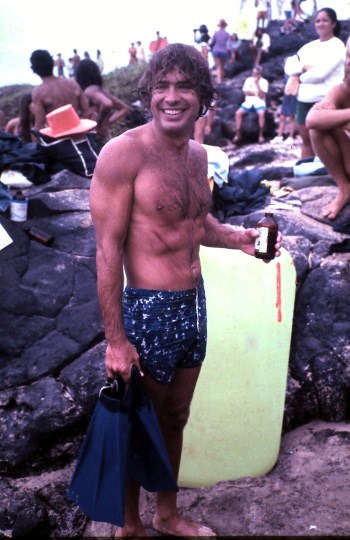 |
Additional comments from Craig Matthew,
"Miggy" (Mike Broderick) might also remember three other
paipo riders
from Makapu`u. "Toby" Tobin was a local haole who was an officer in the
U.S. Navy, in submarines. Toby paipo boarded mostly in the late-1960s
and early-1970s. He made his own board and a couple for two other men:
Pete
Crooker and Ed Stroup, both professors at the University of
Hawaii. Stroup was an oceanography prof, but passed away about 12-15
years ago. Crooker and Toby should be about 70-years-old now. All three
used
boards of the same design and color (a light, lime green). Their boards
were basically flat and rectangular with rounded corners. They seemed
to have a slight taper from the middle out towards the edge." (Personal
email to Bob Green, November
13, 2012).
|
Photo
courtesy of Darel Shea. |
Figures 6.2 and 6.3. Good times at
Makapu`u Beach during the 1960s.
|
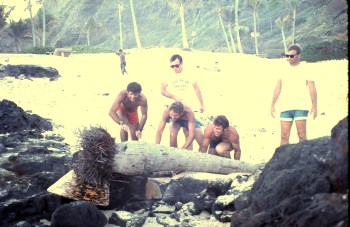
|
|
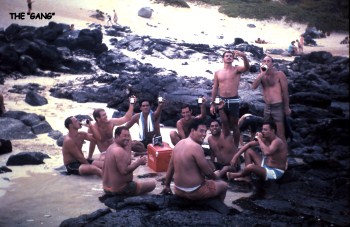
|
(Above
left) Figure 6.2. John
Naughton, Brent Hancock (???) and Jim Riley trying to move a palm-tree
trunk on top of Riley's board. David Holzman and Mike Broderick (far
right) look on.
(Above right) Figure 6.3. Around the cooler: (left to right) Daryl Aiwohi taking a
swig, Jim Riley, Dudie Ho (???). Albert Kaalele or Black Lum King,
seated in the background, is Larry Mac Arthur. Donald Wong is turning
around in the foreground. Seated holding up a beer is Jerry Waiolama.
Standing behind him is John Naughton. Seated in the white/blue shorts
and taking a sip is Renny Kruger, and standing with a bottle to his
mouth is Randy (Guchi-naka) Moore.
Photos
courtesy of Darel Shea. Photo identification by Craig Matthew.
|
7. How did you come to meet
Val Valentine. When was this?
I met Val in the
early 1960s, when I started
surfing the North Shore with John Waidelich. When we rode Sunset, John
would park at Val's house, which was on the beach at Sunset. One time
Val filmed me on a big wave side-slipping into a surfer below me. My
board ended up on top of the guy's surfboard and he fell on my back.
Those were the no-leash days, so the guy was yelling, "Hold my board!"
but then the wave exploded, he and his board went one way and I on
my board went the other.
Figures 7.1 and 7.2. Mike
side-slipping down a wave at Sunset moments before colliding with the
foot surfer.
|

|
|
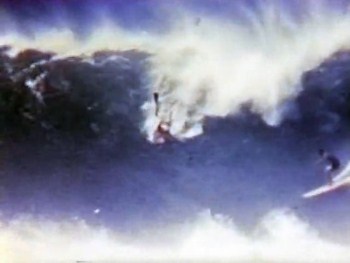
|
Mike
writes, "That was me going up
the back side of the surfer board. The wave was too steep and I side
slipped down onto the back side of his board. He falls on my back and
yells in my ear, "Hold my board, Hold my board!" There we were, my paipo
on his board, the surfer on my back and me thinking I have to get away
from that surfboard and there was an explosion and I went one way the
the board and the surfer went the other. That's my head poking up for
air. Don't know what happened to the surfer. I never saw him again.
When Val came out with the Sunset paipo footage of me going up the back
of the guys board, he described it as. "And Mike Broderick got
penalized 15 yards for clipping!" Everyone had a good laugh."
Photography
by Val Valentine, music and editing by Stig Waidelich in the video, Paipo Surfing 1958-1965. |
8. Did you spend much time
with Val? What can you tell me about him?
I only saw Val on and
off, whenever we parked
at his house, so I didn't really spend much time with him. But he gave
me one of his first boards, a Paipo Nui, which was lighter and easier
to handle than the heavier plywood I was riding. I put a photo of
playmate on my original home made board and black and white racing
stripes on the Val board. I kept it for a long time until it finally
delaminated, sitting in my garage, so I threw it away.
|
Figure 8.1. Pictured below left are Mike
and his wife, Jan along with Mike's Paipo Nui board with the black
and white racing stripes.
|
|
Figure 8.2. Below right are Mike & Jan and Jim & Ginny Bush (Mike's cousin). Jan is holding Mike's fins and board. Yokohama Beach, 1966.
|
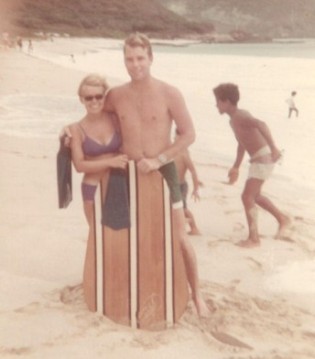
|
|
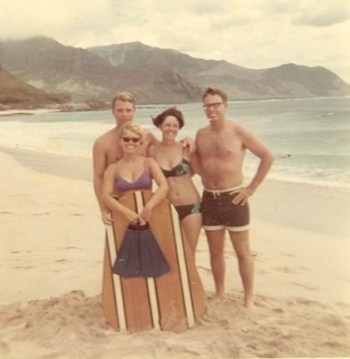 |
Photos
courtesy of Mike Broderick.
9. Did you stick with the
same board over the years or did you experiment with different types of
boards?
I met John Waidelich
when I was in high
school, and I made a board based on his design with a scoop in the
front. My older boards would side-slip, but John's design didn't.
Except for that foam board I made that broke at Makaha, I pretty much
just stayed with the board that I made with John's design. I rode it
everywhere, on small days and big days, and I still have it at home.
Figure 9.1 (left) and Figure 9.2 (right). Mike with
his board from the 1960s (minus the Playboy Playmate).
|
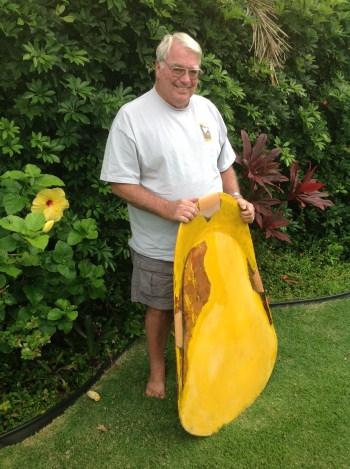
|
|

|
Photos
by Sachi Clark, courtesy of John Clark.
Figure 9.3 (below left) and Figure 9.4 (below right). Mike's 16.5 pound paipo from the 1960s.
|

|
|
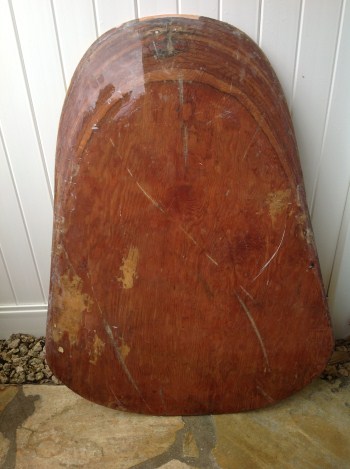
|
Photos
by Sachi Clark, courtesy of John Clark.
10. Did you have any other
favorite spots to surf beside Makapu`u? Would you see many paipo riders
out in the surf?
In
Waikiki, I used to ride Publics and Castles. One time I rode a wave
from Castles to The Wall. You can do it as long as you're planning out
in front of the wave. I really liked Yokohama on a big south swell.
It's got a nice long wall. I had some big days at China Walls at
Portlock Point. The biggest surf I ever rode was about 15-foot at Sunset
and a really big day at Sandy Beach, in the 1960s, when the pier for the
sewer pipe was there. I didn't ride Waimea or the Pipeline. I never saw
too many paipo riders at the other spots, especially at Ala Moana and
on the west side. We'd be the only ones out.
Figure 10.1 (below left) and Figure 10.2 (below right). Mike
riding high and out on the shoulder with John Waidelich below and deeper, at Sunset.
|

|
|
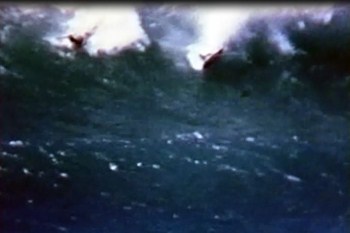
|
| Mike writes, "There is a few shots in
there (home surf movie) of Jim Growney and Mike Irwin in the beginning. Jim had the red
board to start with and John the green. At Sunset it was John and I.
After my shot going up the surfer legs starts the footage from Sandy
Beach. A lot of footage of me and John now has a red board. At times we
both caught the same waves. John had more hair than I did so I tried to
line up more in the less critical area. So I am on the shoulder and
John was on the left. Sure glad that John's son found the movie and had
it fixed up." |
Photography
by Val Valentine, music and editing by Stig Waidelich in the video, Paipo Surfing 1958-1965.
11. What skill was involved
in riding a paipo?
You
had to be in good shape and you had to be able to swim, especially in
big surf if you lost your board. I used fins, Churchills first, then
Duck Feet. I liked them because they floated. On calm days at Makapu`u
we used to dive for fins that sank.
Figure 11. John Waidelich riding a large Sandy
Beach.
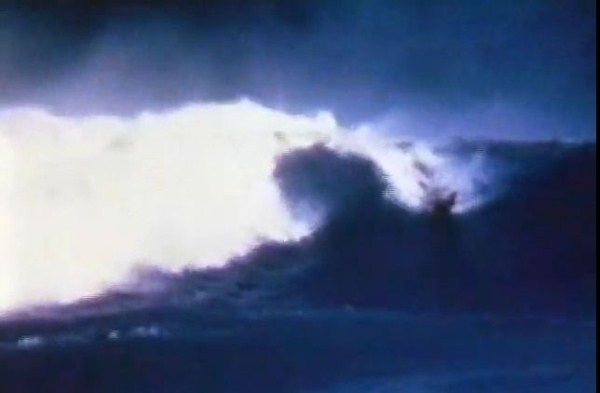
In one of the
Sandy Beach shots John loses his board and in the process put a hole
through his bottom lip. When I saw him after that in the water he was
blowing water through it with his mouth closed. That didn't stop us, we
kept going.
The last shot is of John and was described by Val in his
surf movie as the greatest paipo ride of all time. John and I got out
by going out at the temporary pier that was installing sewer pipe for a new
sewer out fall. It went out about 100 yards and had a crane on the end
of it to lower the pipe in the water. We crawled on the rail as far as
we could and jumped in. There was too much current and to many waves to
get out normally. As we were trying to get out the waves were breaking
on the crane and pushing it in on the track, kind of hairy. The body
surfing guys tried the same thing but never made it out. (See Note 1.)
John
and I and some surfers were the only ones. Val had his camera on the
side of Kam highway about half way to the blow hole. You can tell be
the camera angle were the break must have been. The whole body surfing
beach was closed out and the break was 100 to 150 yards off the beach.
I have not seen it ever break like that again and no one could remember
ever breaking like that prior to that. You may be able to contact the
city and county sewers division to see if there are pictures of the
temporary pier for the sandy beach sewer treatment plant. The pier was
removed when the plant was completed. At that time I believe that John
and I and Jim were the only ones paipo surfing on the north shore. I
never tried Pipeline or Waimea. John may have tried Waimea.
Photography
by Val Valentine, music and editing by Stig Waidelich in the video, Paipo Surfing 1958-1965.
12. What was the attraction
of riding a paipo?
With
a paipo you can get on the waves earlier and faster than you can
bodysurfing, and it's easier to get out of waves. You just go out the
back. You can rest on a paipo board, but they're not buoyant enough to
be a problem on the big sets. And on a really big wave, you can fly, go
really fast. I liked the speed.
13. When was the last time
you rode a paipo and who is still around from your paipo riding days?
The
last time I rode a paipo was in 1985, when I was about 40-years-old. I
had a family, I was playing volleyball, and I really got into scuba
diving. I still dive today. There aren't too many paipo riders around
now, but I dive with two guys who bodysurfed at Makapu`u back in the
day, Darel Shea and John Naughton.
14. Makapu`u Beach Culture (Many of the following photographs need people identification or other minor corrections. If you can assist, please send an email with information identifying the figure number.)
|
Figure 14.1. Relaxing at the beach.
|
Figure 14.2. A young, Charles "Black" Lum King. |
|

Far
left, clockwise: Diana Riley
(Jim's wife), Black Lum-King,
Maxeen Shea (Daryl's ex-wife), Donna McLanahan (Keoki's wife), Judy MacArthur (Larry's wife).
|
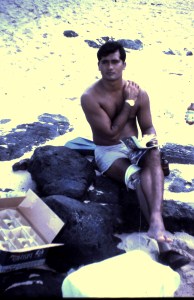
|
Black lost his lower right leg in Viet Nam. Black would leave
is artificial leg on the beach, hop into and out of the water to
bodysurf and every once in a while one of the regulars would borrow the
leg... sometimes to bury it with only the foot sticking out of the sand,
sometimes it would be set next to a stranger who was asleep for them
to wake up to, sometimes (usually later in the day and after several
beers), it would become a beer stein - the cup of it where the stump
fitted, filled with beer and the leg passed around. Black would be told
to wait until we finished the round or just join us. He usually would
do that. One of those times where you had to be there and in the same
condition for it to be funny. |
Photos
courtesy of Darel Shea. Photo identification by Craig Matthew and Mike
Broderick.
Figure
14.3 (below left). Clockwise, starting with Larry MacArthur holding a
beer on the far right are Daryl Shea, Black Lum King, Joel Nevels or
Andy Speece (?) with his back to the camera, Albert Kaalele,
unidentified person wearing a blue shirt, and a beardless Craig
Matthew is crouching in the back. Standing and wearing a white shirt is unknown. Joel Nevels lifeguarded at Makapu`u from 1970-72)(?).
|
|
|
Figure 14.4. Jaren Hancock and Jim Riley. |
|
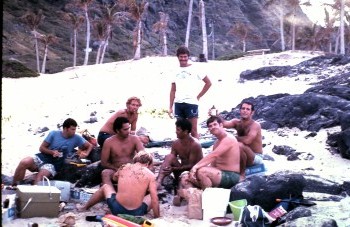
|
|

|
Photos
courtesy of Darel Shea. Photo identification by Craig Matthew and Mike
Broderick.
|
| Figure 14.5. "Waha nui" or "too
much talk" are (L to R) Jerry Waiolama, John Naughton, Black Lum
King and Jim Riley. |
|
Figure
14.6. Looks like they're coming out of the water from a
contest heat. In the foreground is Gordon Smith, followed by
Jim Riley, John Naughton and unidentified bodysurfer.
|
|
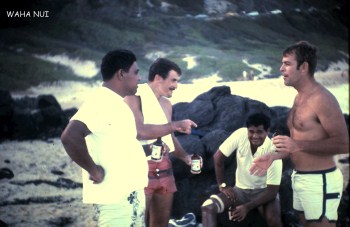
|
|
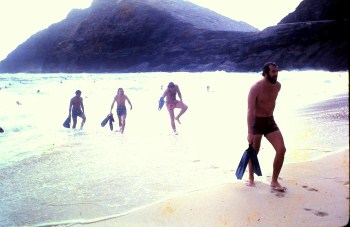
|
Photos
courtesy of Darel Shea. Photo identification by Craig Matthew and Mike
Broderick.
|
| Figure 14.7. Jim Riley with
the white visor, Jerry Waiolama taking a sip and Darrel Aiwohi in green
t-shirt. |
|
Figure 14.8. Robin Bond and John Naughton. |
|
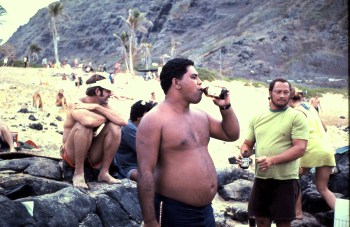
|
|
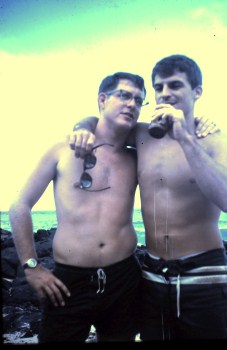
|
Photos
courtesy of Darel Shea. Photo identification by Craig Matthew and Mike
Broderick.
Figure 14.9 (below left). (L-R, clockwise) Robin Bond (standing), Sam Herric (bent over in orange shorts),
Larry MacArthur (center seated in back), unidentified (seated upper
right), Bill Westermeyer (foreground in the white t-shirt), Jan
Broderick (Mike's wife), and David Fleming (the young boy, Mike's
nephew).
Figure 14.10 (below right). (Counter-clockwise from far right) Sam Herric (standing, rust colored shorts), Black Lum King,
"Dinty" Moore, Mike Broderick (standing, yellow shorts)
and Jan Broderick (Mike's wife).
|
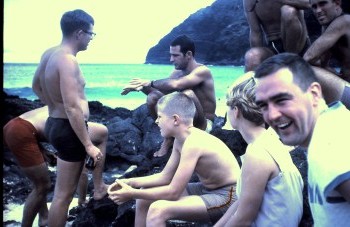
|
|
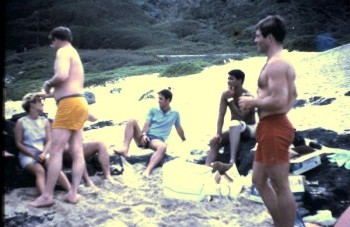
|
Photos
courtesy of Darel Shea. Photo identification by Craig Matthew and Mike
Broderick.
Figure 14.11 (below left). (clockwise, more or less, from far left) Black
Lum King (standing with back towards camera), John Naughton (bent over),
Jim Riley talking to Jerry Waiolama. In the background is Diana Riley
and her three daughters, Anne Marie Naughton (John's wife) and Maxeen
Shea, Darel's wife. Unidentified person wearing a blue shirt in right foreground.
Figure 14.12 (below right). (L to R) Larry MacArthur, Mike Broderick and John Naughton.
|
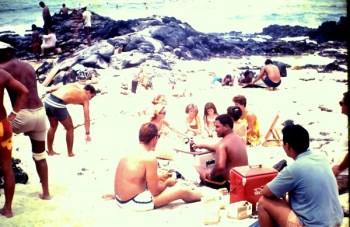
|
|
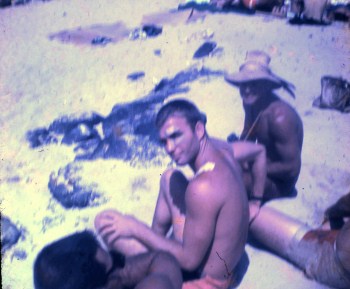
|
Photos
courtesy of Darel Shea. Photo identification by Craig Matthew and Mike
Broderick. |
|
Figure 14.13. Seated to the left is Jim
Riley. On the right are Jaren Hancock and his girlfriend.
|
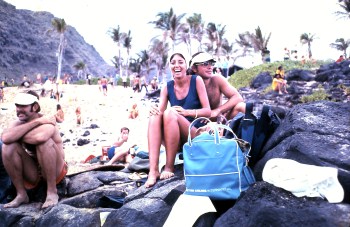
Photos
courtesy of Darel Shea. Photo identification by Craig Matthew and Mike
Broderick.
|
|
Note 1:
Additional comments
from Craig Matthew: "Four or five of us
(bodysurfers) did make it out and bodysurfed one day of it. There were
probably only 8-10 people outside catching waves, but we would take off
bodysurfing, the waves would wall up and we'd be almost skipping along,
we were going so fast. We'd be cutting out towards past the other end
of the beach area, but about a 100 yards offshore of the Blowhole. It
was a LONG swim back to the lineup in blue (deep) water. My memory of
it is that those were some of the biggest and fastest waves I'd ever
bodysurfed. I remember Naughton, MacArthur, Shea, and myself out there,
there might have been 1-2 more bodysurfers, 4-5 paipos ( I think Harry
Akisada was there too), later a couple of surfers made it out, but they
were lining up away from us. Whew! What a day!" (Personal
email to Bob Green, February 28, 2013.)
"Out of all the people listed there, most were bodysurfers. Some
dabbled in paipo surfing, but the only people who paipo boarded
regularly
would have been Mike Broderick and Renny Kruger. Donald Wong and Albert
Kaalele would switchback and forth between the two" (Personal
email to Bob Green, February 25, 2013.)
|
|